It is now three and a half years since Historic Environment Scotland (HES) closed the Radical Road below Salisbury Crags in Edinburgh and it was good to see the BBC pick up the story last week (see here). HES has also been in the news recently (see here) and (see here) because of its proposals to abandon maintaining historic buildings which it is charged with protecting. In the last eight months HES has introduced access restrictions to no less than 70 of its buildings and grounds: 20 in June; 11 in November; and 39 in January (see HES news release for locations). Just like the Radical Road, HES has used Health and Safety as its justification and has been blaming the underlying problems – the state of the rocks/masonry – on climate change. In both cases it appears that HES has proceded with the closures without giving proper consideration to access rights. This post takes a further critical look at what is going on following my post last August (see here) and subsequent investigations.
Climate change and the erosion of buildings and rocks
HES’s news release on 21st January had the bold headline: “New measures introduced to manage the impact of climate change on Scotland’s national heritage sites”. In the text below it qualified this slightly “While our changing climate is not the sole reason for deterioration, it has certainly accelerated it and brought the issue to a head”. The Herald article revealed the other reasons HES believes properties are deteriorating are visitor footfall – really, for falling masonry? – and “age”. Nothing was said about the impact of atmospheric pollution on buildings or whether maintenance programmes over the last 20 years have been adequate.
Why climate change should be making it impossible for HES to maintain many of its historic buildings is not immediately obvious. Scotland may be getting wetter (27% more precipitation in the century to 2014 (see here)) but it is also getting a lot warmer (29 fewer days a year when there was ground frost). Erosion caused by water may be increasing, but that caused by freeze-thaw – which affects ruins as well as crags – must be decreasing. So how do the two balance?
Since the potential impact of climate change on buildings and cliff faces appears to me far from simple I had a look at HES’s publications and work on climate change (see here), which mentions research on the “chemical effects of warmer, wetter winters on Scottish sandstone” . I found nothing about the impact of climate change on buildings though there is a lot, for example, about how poor maintenance of sandstone can increase erosion. Maybe the research results are hidden away somewhere on the HES website, which is not the easiest to navigate? But if the claims of HES’s senior managers about the impact of climate change were backed by their research, why not refer to that in the news release? And more importantly, if its true, why has HES not been warning the Scottish Government about the impending catastrophe that is about to hit Scotland’s sandstone settlements, starting with Glasgow? Why isn’t there a wider building emergency?
The HES Board were told in June 2019, in a paper (see here) on Holyrood Park which I obtained through a Freedom of Information request and which they have still not published, that:

A correlation between climate change and increased rockfall does not explain the causation. First HES implies increased precipitation and high impact weather events are responsible – are the crags being blown down? Then it states it’s the spread of Valerian that is the problem and it attributes this to warmer weather and increased precipitation which if true means that the impact of climate change is at most INDIRECT. That may be the case, but again causality is complex. There has been some fascinating research in the USA (see here) into how Valeriana Edulis, which is closely related to our Valeriana Officinalis, has responded to climate change. This found male and female plants responded DIFFERENTLY to the changing climate in Colorado’s rocky mountains! This suggests there might not be any simple explanation to the spread of Valerian in Holyrood Park. The point, however, is that while HES obviously cannot do anything about climate change it could do something about the Valerian and at a reasonable cost.
All of this suggests that the HES’ attempt to use climate change to justify the closure of both its historic buildings and the Radical Road is only an excuse. The real explanation for the closures is that HES have not got enough money to look after what they charged with protecting: one suspects that d their Board are not prepared to tell the Scottish Government this through fear of having their budgets cuts even further.
HES’s access restrictions and the Land Reform Act
The Land Reform (Scotland) Act 2003 included historic and cultural sites within access rights, with two important exceptions. Access Rights don’t include cultural sites where paid entry is required but more importantly for the cases being considered here to buildings or their curtilage. This means that HES were quite within their rights to restrict access to buildings where there is a danger of falling masonry for health and safety reasons.
The issue, however, is the land round about. The list of access restrictions on the news release shows that HES has responded to the danger of falling masonry by automatically trying to impose access restrictions over entire sites and then considering what parts, if any, could be safely re-opened. For the 40 sites closed in January HES states “assessments currently being undertaken on site to open up as much access as is safely possible“. In imposing blanket restrictions, HES have acted beyond their powers and therefore, where restrictions extend beyond the curtilage of buildings (and places where there is any conceivable risk from falling masonry), I would encourage readers to submit complaints to their local access authority.
The exception to this is Holyrood Park where the Park Regulations, as I explained in my first post, were never amended after the passing of the Land Reform (Scotland) Act as they should have been. Those regulations give HES the power to make up its own rules on access. This was covered in the 2019 HES Board Paper on Holyrood Park (link here again):
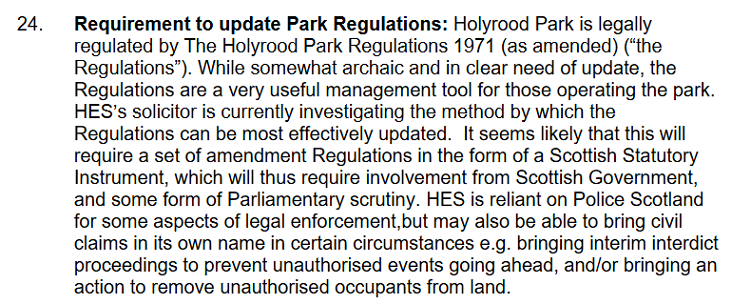
So, there you have it: the Park Regulations – although “somewhat archaic”- are a very convenient means of HES being able to do what they like and ignore the Land Reform (Scotland) Act. The claim that changing the regulations is complex is rubbish. The Scottish Parliament has the power to issue new regulations repealing the power of HES to impose its own management rules. Repealing parts of statutes is a relatively simple process and indeed the Holyrood Park regulations should have been amended when the Land Reform (Scotland) Act was passed.
At the same time as requesting the offending regulations were repealed, HES could ask the City of Edinburgh Council, as the local access authority, to consult on new byelaws to cover Holyrood Park as set out in Section 12 of the Land Reform (Scotland) Act. While such byelaws would allow activities to be controlled as now, what they would not do is allow HES to close areas of land indefinitely. Under Section 11 of the Land Reform (Scotland) Act if a landowner wants to exempt land – such as the Radical Road – from access rights for more than six days consent is required from Scottish Ministers.
The processes set out under the Land Reform (Scotland) Act were intended to create transparent processes around access restrictions and enable the public to have their say. HES, however, has hidden behind the extraordinary powers it was given in the Park regulations and has made absolutely no attempt to consult about the closure. I have been informed by Mountaineering Scotland, which has been trying to take up the issues, that as of November 2021 the Edinburgh Local Access Forum, the statutory body responsible for advising on access rights locally, had not been consulted about the closure. Unfortunately, information about the Edinburgh LAF (who is on it, meetings, papers) is not public, so you cannot tell what they have and have not been considering.
There are suspicions here that there may have been collusion between City of Edinburgh Council officials and HES to allow them to manage Holyrood Park without reference to the Land Reform legislation:
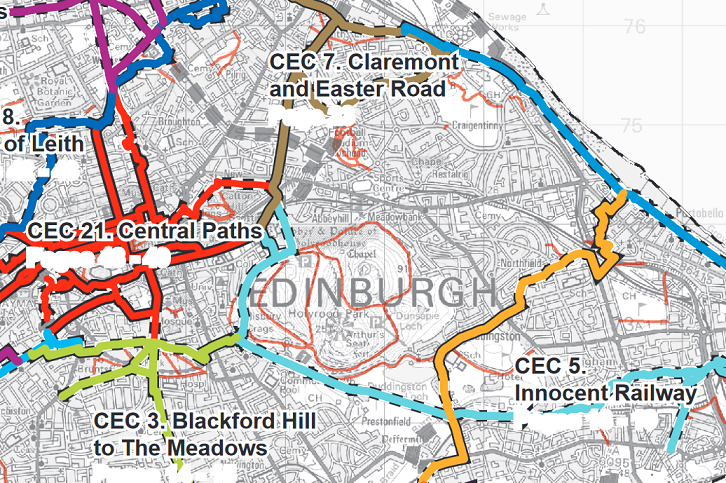
Why for example was Holyrood Park left out of Edinburgh’s core paths plan? If the Radical Road was a core path, HES couldn’t have arbitrarily closed it as they did.
In my FOI I asked for any papers presented to the Board about the closure decision. I received just the paper for the June 2019 meeting. My conclusion from reading that and the minutes of Board meetings for the last three years is that the decision to close the Radical Road was taken by staff, not the Board. But since then Board Members have done nothing to challenge staff about their decision.
Following consideration of the Holyrood Park paper in June 2019 the minutes of that meeting record:

Two and a half years later there appears to have been little progress on the Strategic Plan for Holyrood with the HES Board minutes from September 2021 recording:
“The Board noted that the development of the Holyrood Park strategic plan was being taken forward under business as usual planning. Members requested that this be within the next 12 months”.
There appears therefore to be no end to either the closure of the Radical Road or the review of the Holyrood Park Regulations in sight.
Health and Safety and the access restrictions
In my last post I considered some of the complex issues surrounding access rights, risk and health and safety. It is worth adding some observations here.
Over the last few years as a result of blogging on parkswatch I have met and communicated with a number of front-line staff responsible for health and safety (e.g .over access being closed for forestry operations). I have found all to care passionately about safety but at the same time to be very clear about assessing risks and what safety measures might be needed and why. I have found that when it comes to the outdoors it is not health and safety staff who tend to be risk averse but other frontline managers and senior managers (because its easier to say no than assess risks). That appears likely to be the case at HES.
Whatever the risks on sections of the Radical Road there would appear to be little or no risk at Hutton’s Section, the world famous geological site, yet HES fenced that off just as it has now closed access to the grounds around some its crumbling buildings. It is HES Management that appears to be the problem here, not falling stones or rocks.
That is confirmed by the report from Fairhurst, dated March 2019, on Annual Rock Slope Inspections 2019 (also obtained through FOI though it had already been released to someone else- it’s 15 MB so too big for this website).
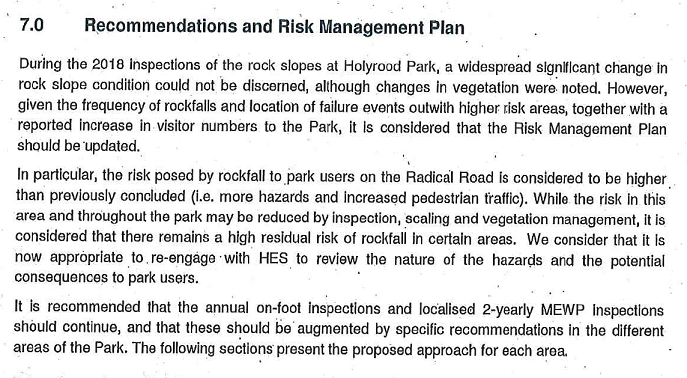
While Fairhurst said the risk of someone being hurt by rockfall was increasing, both because of the number of rockfalls and the increased numbers of people visiting Holyrood Park, they did not draw any conclusions about the potential consequences to Park users (i.e whether there was a significant risk of people being hurt). Rather they recommended that HES should conduct its own risk assessment, to “review of the hazards”. If HES has conducted a further risk assessment, it’s not been made public.
As part of my FOI request I asked for information HES held about incidents involving rockfall and people and received this: seven incidents at Edinburgh Castle, one person hurt. Now, I am not claiming there have been no near misses on the Radical Road, only that HES appears to holds no information to substantiate the decision by senior staff to close it. But any proper risk assessment would also have differentiated between risks along different sections of the Radical Road and, given the topography, it’s difficult to believe there could have been any justification for closing it in its entirety (indeed as I pointed out in my last post Rangers were, on request, letting people through the fence to view Hutton’s Section).
A proper risk assessment, however, would not just assess the risks of being hit by a falling rock on different sections of the Radical Rd, it would consider those risks within the wider context of risks at Holyrood Park and how such risks are managed in the countryside. Having closed the Radical Road far more people are now walking along the top of Salisbury Crags: so why is the risk of a section of crag collapsing below a person’s feet judged less than the same section of crag falling on someone’s head?
In the last week the tragic story of the woman apparently pushed off Arthur’s Seat by her husband has again been in the news, with some of the media showing photos of Arthur’s seat and some of Salisbury Crags (see here). The fact that accidents and even murders can happen in rocky places should not in itself be sufficient to close them off and at present those risks appear to be greater than those posed by rockfall.
While in my last post I was very critical of what the Highland Ranger Service had said about access rights and fires (see here), this is their response to a large landslip in the Quirang which took place in October:

This was a landslip which swept over a path in an area very popular with tourists (not seasoned mountaineers):
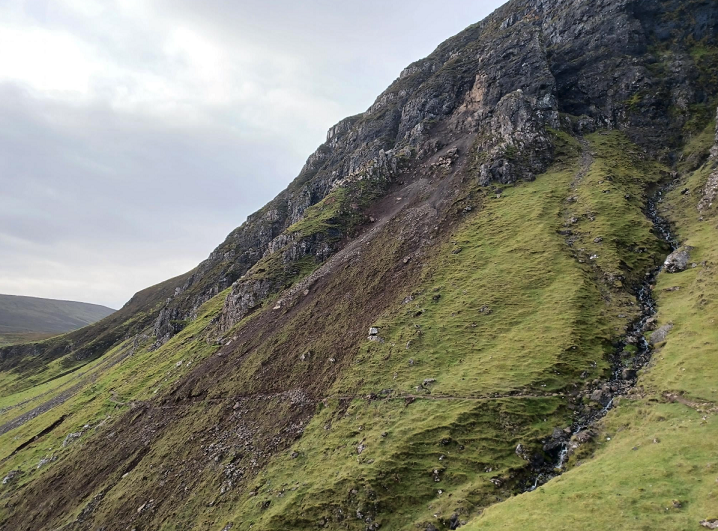
The Rangers left people to make their own judgement – I think that was absolutely the right thing to do (although some might say that letting the photos speak for themselves was not enough and they might have added a warning). Contrast that approach to the one HES has taken in Holyrood Park.
What needs to happen?
It should be a matter of great concern nationally that the historic Radical Road, which is so important for outdoor recreation, geology and tourism has been closed now for three and a half years and that HES appears to be doing nothing meaningful to address the problems. Indeed, having been allowed to get away with the Radical Road closure they now appear to be applying a similar approach to their other properties. Rather than using the expertise of their staff to fix problems – and there is still considerable expertise within HES – they are restricting access because senior management and the Board see that as the cheap option.
As I argued in my first post, we need MSPs to insist that the Scottish Government repeal the Holyrood Park regulations and insist that HES manages the park within the framework set out in the Land Reform (Scotland) Act. There appears absolutely no point in asking civil servants to do anything as this extract from a letter to a reader sent by CHEME (Culture and Historic Environment at the Scottish Government) shows:
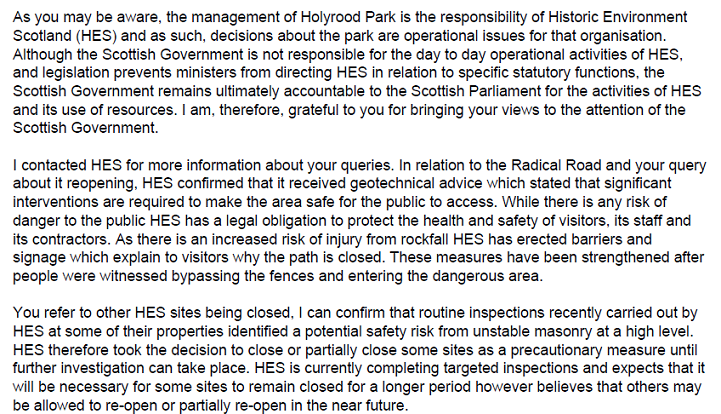
Who should be responsible for determining whether the Park Regulations are fit for purpose if it’s not the civil servants? All this letter does is regurgitate HES’s justification for their failed management.
The most likely way therefore we will achieve change is if City of Edinburgh Council and Edinburgh MSPs call on the Scottish Parliament to do so. If therefore, you are a resident in Edinburgh please lobby your MSPs and councillors…….and remember there is a local election coming up so you could ask candidates if are prepared to sign up to the repeal of the Park Regulations and bring them into line with the Land Reform (Scotland) Act..
Meantime, where HES is trying to impose restrictions on other properties where access rights apply, people should use the legal framework offered by access rights and ask their access authority to intervene.

Thank you Park Watch!
The closure of the world famous Radical Road in the centre of the capital is dramatic example of:
. Not consulting with users and relevant communities of interest
. The inability to assess risk in a practical manner. The risk of rocks falling off a cliff and causing a fatality are self-evidently miniscule compared to all the other risks.
. Using Health & Safety as a cover for management failings. The state of the park as a whole is a disgrace.
. Ignoring wider responsibilities to access and the heritage, damaging Scotland as a whole.
This would seem to come about as HES has no effective external scrutiny, parliamentary or otherwise.
There would appear to be parallels with this case and the precedents cited:
https://www.scotways.com/court-cases/358-michael-leonard-v-the-loch-lomond-and-the-trossachs-national-park-authority
“use of the path didn’t involve exposure to any special or unfamiliar hazard”
Common sense would say that for any path in the vicinity of crags or rock formations the possibility of falling rocks is not a “special or unfamiliar” hazard.
“there is no duty to protect against obvious or familiar natural features”
The climate change argument is essentially an example of spin. One aspect is the huge dent in HES’s finances due to the closure of its money-making sites, particularly Edinburgh Castle. Another aspect is the diversion of funds for a significant period into new projects. I don’t see actions such as repealing the Park regulations as happening anytime soon. It’s about money and whether it’s a priority for politicians.
What a surprise…
https://theferret.scot/edinburgh-footpath-facing-permanent-closure/
“An internal report by Historic Environment Scotland (HES), obtained by The Ferret, reveals that the leading option for Radical Road around Arthur’s Seat is to “permanently prohibit all access”. The route has been fenced off for more than three and a half years because of the risk of rock falls.
The prospect has alarmed walkers, climbers and geologists, who warned that permanent closure would create “a terrible precedent”, putting public health and tourism at risk. They accused HES of failing to consult or to listen, and of assuming it “knows best”.”
I see Nick has made a very good comment within the article…
It looks to me that these notes are essentially a waste of time. Why? Check the number of comments. At the time of making this one, it’ll be the eighth. Eight comments – in 26 months? Scots would seem to have little interest in these matters, which surprises and appals me. That it surprises me is maybe more a comment on how disconnected am I from the trends of public interest…
On looking for the chance to comment here I’d expected to find an avalanche of rage against the clear status of not-fit-for-purpose that applies to the administering body in charge of our irreplaceable landmarks.
As for funds, Edinburgh seemed to see no issue with the outrageous waste of public money involved with “gaelicising” street signs, signage on ambulances, police vehicles and nurse uniforms. I recall at the time checking on the number of gaelic speakers (all of whom are bilingual and are able speakers of English) which in 2021 was found to be capable of being spoken by – 60,000 people in Scotland. That was ABLE to speak Gaelic, not that they habitually did so. That’s about 1% of the population. So – when a matter of political ideology is seen as cause worthy, funds are found despite the nonsensical state of pushing Gaelic – nearly entirely spoken in the Western Isles. I had an old pal years back who had been sent home on his first day at school in Kintail with a letter to his parents saying to send Angus back to school when he had enough english to understand his teachers. At the time he told me that although in the 1940s/50s it was the common tongue around the houses, almost nobody wrote or read it. He couldn’t himself.
The Edinburgh “government” needs to be put on the spot here with a formal enquiry into the national disgrace still ongoing at these sites that should be openly and unrestrictedly available to visitors, or our tourist trade will suffer as a direct result.
Till the findings of such are published, all there will be from “Historic Environment Scotland” is fiction and evasiveness. Lord knows, the ruling party in Holyrood these past umpteen years has been shown to be incapable of keeping its own affairs in order. They’re obviously similarly incapable of being trusted to look after our irreplacable historic assets
My uncle was the custodian at St Andrews Cathedral for some years, and at that time there was a team of stonemasons centred there who maintained the structure of the remaining buildings. There seems to be no trace of any such nowadays. These men would maintain not only the cathedral and castle, but also other sites in Scotland too by arrangement.
When did this discontinue? It’s not the sort of thing that’d be trumpeted openly to the public. It seems that now the cost saving of those skilled men’s dismissal has come home to roost in no small way. That’s what happens with centralised control where there’s little or no connection between the decision makers and the sites being allowed to rot.
I disagree with your arguments about expenditure on Gaelic being a waste of money but the core of your argument is right. The Radical Rd could be re-opened tomorrow if either the City of Edinburgh Council enforced access rights or the law on rights of way.